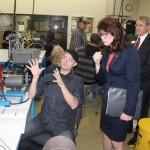Manufacturing professionals and educators have been working for years to change the image of the industrial sector.
Building an Image
By Eau Claire Leader-Telegram
November 7th, 2014-Baldwin-Woodville High School student McKenzie Kohl was looking for reassurance about the future of manufacturing in Wisconsin.
“My grandfather was a welder who came home looking like a coal miner every day,” Kohls told state’s Lt. Gov. Rebecca Kleefisch and a panel of manufacturing experts gathered at Chippewa Valley Technical College in Eau Claire Tuesday, “How has manufacturing changed?”
Panel members spoke to Kohls’ question, hoping in the process to dispel the idea that manufacturing is a dirty job.
Mary Isbister, president of GenMet, a metal fabricator in Mequon, said welding and most other manufacturing jobs are no longer dirty professions.
“You can’t have smoke and dust and dirt in places that have advanced manufacturing equipment,” Isbister said. “The equipment that we use, and the processes that we use, have advanced light years. It doesn’t look like it used to.”
Panel members were attending a Women in Manufacturing even at CVTC in recognition of October’s designation as Manufacturing Month. The event, sponsored by Wisconsin Gold Collar Careers Manufacturing Works Group, included a tour of CVTC’s Manufacturing Education Center and a public-private speed networking session.
Students from Eleva-Strum and Baldwin-Woodville schools attended the panel discussion in person while their counterparts in Bloomer, Cumberland, Gilmanton, Pepin, Shell Lake, Turtle Lake, and Webster schools followed the event via video conferencing.
Manufacturing professionals and educators have been working for years to change the image of the industrial sector.
“We still have people who view manufacturing as a dirty place with things lying all over,” said Craig Semingson, superintendent of the Eleva-Strum school district, which received praise at the event for having one of the best manufacturing education programs in the state. “But these are professional places where you’re not going to wear your Metallica T-shirt to work every day.”
Dawn Tabat, chief operating officer of Generac Power Systems, a Wisconsin home generator manufacturer with facilities in Whitewater, Waukesha and Eagle, acknowledged there was some truth to manufacturing’s poor image in years past.
“There were a lot of people making good money in manufacturing for what were pretty low-skilled jobs,” Tabat said. “But those unskilled jobs are gone. U.S. manufacturing got smart. These are jobs that are going to require a lot of special skills. There’s a whole new world in manufacturing.”
Kleefisch echoed that sentiment. “These are smart jobs’,” she said. “We need your brains. We need your bright ideas in manufacturing.”
More Schooling
Dan Conroy, vice president of human resources at Nexen, a manufacturer of power transmission and other products with a plant in Webster, said just 12 percent of jobs in his company require only a high school education while 70 percent require a technical college education and 18 percent a university degree. “I always use the term ‘advanced manufacturing.’ We won’t hire you unless you go to school after high school,” Conroy said.
Students asked questions about job opportunities in manufacturing fields and which courses they should be taking to prepare themselves for those jobs. Panelists said a wide range of manufacturing-related jobs are available.
“You can do almost anything within manufacturing, but you have to understand how manufacturing works. Today’s manufacturing operates very complex equipment,” Isbister said, noting students should not only focus on math but should have a broad-based education to be attractive to employers. “There probably aren’t too many classes that wouldn’t be advantageous to you,” she told students.
Women Encouraged
Panel members encouraged women to explore careers in what remains a heavily male-dominated field.
Tabat shared her story of a 42-year rise from production and secretarial work at Generac Power Systems to a human resources job and eventually to chief operating officer. “I started out with a small company and the company grew bigger and bigger, and I grew with it,” Tabat said, noting just 6 percent of company leaders are women. “There are no other places that have a greater opportunity for women to compete on a level playing field than manufacturing,” Tabat said.
“You can use a laser cutter to break the glass ceiling,” Kleefisch said.

